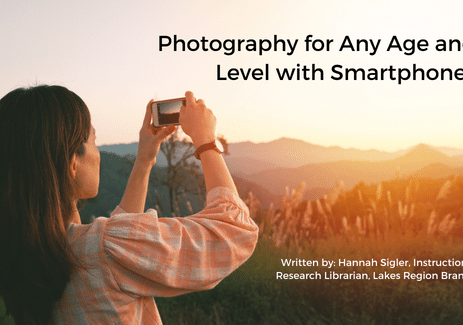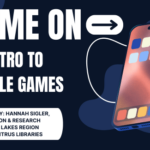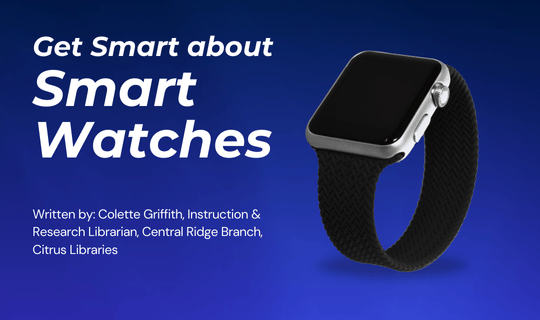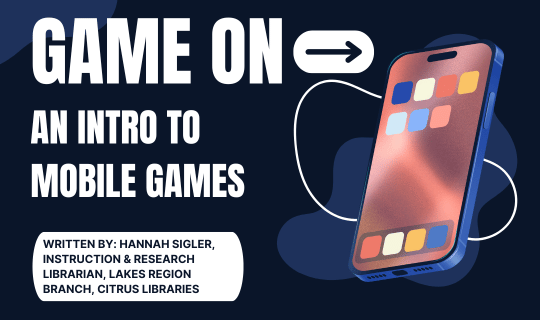Photography for Any Age and Level with Smartphones
Gone are the days of photography being an inaccessible art! You don’t have to buy an expensive camera and special equipment to take good photos—most of us already have a smartphone right at our fingertips! Over the last few years, the capabilities of the average cellphone have well surpassed expectations.
Turn over your smartphone and you’ll likely see not one, not two, but possibly three or even up to five circular lenses on the back. That’s enough to tell you that this isn’t the disposable point-and-shoot of 80s and 90s fame. Depending on your model of phone, you may have one or a selection of the following lenses: a wide-angle or ultra-wide-angle lens, a telephoto lens, or a macro lens, each designed for a specific purpose in mind. The advantage to the beginning photographer who’s just getting started is that, depending on the photography mode selected, the lenses are automatically chosen and used rather than needing to be switched out.
Wide and ultra-wide-angle lenses allow for a greater field of view than the human eye. These allow you to fit “more” into whatever you’re trying to photograph by making closer objects look larger and things that are farther away look smaller. These lenses are touted as invaluable when it comes to landscape photography (for example: when you’d like to include both the foreground and the background in a photo), but they’re also helpful for fitting everyone into a selfie. However, due to these lenses utilizing a forced perspective, photos taken with wide and ultra-wide-angle lenses tend to look curved, particularly when it comes to street photography and portraiture. These can also minimize the impact of large, sweeping images by making everything look small.
A telephoto lens, when applied to smartphone photography, allows for a further enhanced zoom. This is extremely useful for portrait mode, which captures photos with a sharp focus on the subject and a blurred, soft background. Portrait mode is included on models of both Apple and Android phones. The telephoto lens is excellent for nature shots, where you may be taking photos of animals that you can’t (or shouldn’t) get too close to. The degree of zoom you get with your smartphone is going to depend on the particular model that you have.
A macro lens is exactly what it sounds like: ideal for those extreme close ups to capture every detail you can—even those that would be difficult to see with the naked eye! If your phone includes a macro lens, it can usually be utilized by selecting “macro mode” in your camera app, often designated by a flower symbol, or it may be used automatically by zooming into your subject enough.
The different camera modes your phone comes with is going to depend entirely on your model of phone and the operating system that you’re running. This is especially relevant when it comes to phones running off of Android, as each brand will have its own particularities. The following modes are going to be fairly standard between most major brands.
Pano, or panoramic mode, is a fantastic way of taking large, all-encompassing photos when a standard picture just won’t cut it. The way your phone creates a panorama is by taking lots of small photos and stitching them together. When taking a panoramic photo, you’ll be instructed to slowly move your phone while taking the photo—the result will be a very long photo that captures much more than you would be able to by taking just one regular photo. The downside, of course, is that it takes some practice! The speed of your movements and your ability to maintain a steady, consistent height with your phone while in motion are both critical to taking a photo with minimal distortion. If you’re not careful, your beautiful photo could very easily turn into an uneven, wobbly mess.
You’ll also generally be able to shoot in night mode. If you’ve ever tried to take photos outside at night, you’ll know all about those struggles. With an iPhone, this mode is selected automatically if it detects a low-light environment but with many Android devices, it’s a selectable setting. The way night mode works is that when you take a photo, your phone actually takes multiple photos at varying levels of exposure without using the flash. Those photos are merged in order to bring out as much detail as possible, resulting in a single photo that (hopefully!) has a better detail and color balance than it would otherwise. The downside, of course, is that it doesn’t do well at all with moving objects, so it’s better to use this mode for stationary things that won’t need an action shot.
Both iPhones and Android phones allow for what’s called a portrait mode. Portrait mode, as mentioned before, works to focus the subject while blurring the background for a professional look. This is excellent for headshots and pet photos! You can manually change the lighting for a whole different look as well. Portrait mode works best for subjects that are between two and eight feet away from you; if you’re too far or too close, your phone will likely prompt you to fix your distance.
You might also be able to utilize burst mode. This camera mode was made for action shots and allows you take a series of up to thirty photos in one quick burst. This way, instead of asking your subject to repeat a motion, there’s a higher chance of getting that one really great shot.
While your average smartphone will never replace or replicate the experience and equipment of traditional photography, taking good photos doesn’t have to have financial or equipment-related roadblocks. In the end, all you really need is a camera and something beautiful, no matter how it comes.
The Citrus County Library System offers technology classes at all of our branches. For additional information about programming please call your closest branch or visit us at citruslibraries.org. Need some one-on-one help? Give us a call and ask about setting up a technology appointment with a librarian to get you on the right track. As always, library services and programs are free to the public.


















